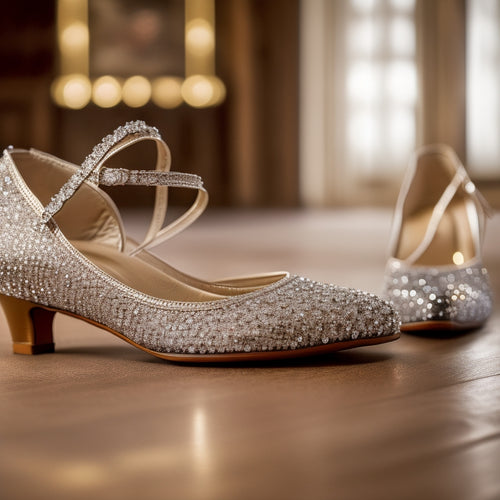
The Dancers' Study Guide Review
Share
The Dancers' Study Guide offers a thorough framework for mastering the art of dance, covering three key areas: dance fundamentals and history, guiding through classes and auditions, and fitness and injury prevention strategies. This guide chronicles the evolution of dance, highlighting cultural influences and famous choreographers' contributions. It also provides practical advice for successfully maneuvering through auditions and classes, emphasizing the importance of preparation, etiquette, and personal space. Additionally, it offers targeted exercises and healthy habits for peak performance and injury prevention. By examining these interconnected elements, dancers can refine their skills and gain a deeper understanding of their craft, paving the way for further growth and exploration.
Key Takeaways
• The Dancers' Study Guide provides a comprehensive exploration of dance fundamentals, history, and cultural heritage.
• The guide helps dancers navigate classes and auditions with confidence through research, rehearsal, and mental preparation.
• Prioritizing fitness and injury prevention is crucial for optimal performance, and the guide offers targeted exercises and nutrition strategies.
• The guide highlights the contributions of famous choreographers and chronicles the evolution of various dance forms, including ballet.
• By following the guide, dancers can improve their skills, reduce performance anxiety, and develop a well-rounded approach to their craft.
Dance Fundamentals and History
The Dancers' Study Guide offers an extensive exploration of dance fundamentals and history, delving into the rich cultural and artistic heritage of various dance forms, from ancient civilizations to modern movements.
This thorough guide chronicles the dance evolution, highlighting the contributions of famous choreographers who have shaped the art form. The origins of ballet are also explored, revealing the cultural influences that have molded this classical dance style.
Navigating Classes and Auditions
In addition to a solid grasp of dance fundamentals and history, dancers must also develop the skills and strategies necessary to navigate the practical aspects of their craft, including attending classes and facing auditions.
Effective audition preparation is vital, as it helps to mitigate performance anxiety and boost confidence. A well-planned approach involves thorough research, rehearsal, and mental preparation.
In the classroom, dancers should adhere to proper class etiquette, including adhering to a respectful dress code, arriving on time, and being mindful of personal space.
Fitness and Injury Prevention
Dancers who prioritize fitness and injury prevention can greatly enhance their overall performance and prolong their careers by adopting targeted exercises, nutrition strategies, and healthy habits. Conditioning exercises, such as Pilates and yoga, can improve flexibility and strength, reducing the risk of injury.
A well-structured fitness routine should also include cardiovascular exercises to enhance endurance and agility. Additionally, dancers should focus on developing strong core muscles to support their movements and prevent injuries.
Frequently Asked Questions
How Do I Balance Dance Training With Other Aspects of My Life?
As the ancient Greek aphorism "know thyself" echoes, balancing dance training with life's demands requires astute time management and prioritization, harmoniously allocating hours to nurture both artistic passion and personal well-being.
Can I Still Dance Professionally if I Have a Physical Limitation?
Despite physical limitations, it's possible to dance professionally by embracing accessible choreography and adaptive techniques, which cater to individual needs, empowering dancers to excel and thrive in the industry.
What Are Some Tips for Overcoming Self-Doubt and Performance Anxiety?
To overcome self-doubt and performance anxiety, employ mental reframing techniques, replacing negative thoughts with empowering ones, and utilize positive affirmations to rewire your mindset, fostering confidence and resilience in the face of performance pressures.
How Often Should I Take Breaks to Rest and Recover From Intense Training?
As exhaustion creeps in like a thief in the night, stealing vitality and precision, it is crucial to prioritize fatigue management by incorporating regular rest intervals, allowing the body to rejuvenate and rebuild, ensuring peak performance and minimizing the risk of injury.
Are There Any Specific Stretches or Exercises for Preventing Common Dance Injuries?
To prevent common dance injuries, incorporate flexibility exercises targeting hamstrings and hip flexors, along with muscle strengthening exercises for core engagement and posture correction, as part of a thorough injury prevention strategy.
Related Posts
-

3 Essential Tools for Dance Makeup Artists Online
As a dance makeup artist, you already possess the skills to create stunning looks, and with the right digital tools, ...
-

Elevate Your Dance Makeup Business Online
You're one step away from taking your dance makeup business global. A professional online presence is key, with 75% o...
-

Best Ballroom Dance Shoes for International Style
When you're selecting the best ballroom dance shoes for International Style, focus on essential features like grip, c...


